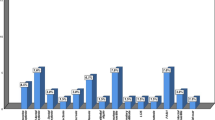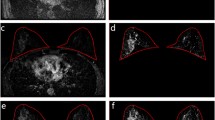Abstract
Background
Just as mammographic breast density influences mammographic sensitivity, the degree of background enhancement in breast magnetic resonance imaging (MRI) may influence the sensitivity of breast MRI. The purpose of this study is to assess the influence of background enhancement on the accuracy of breast cancer extent assessment using MRI and to assess the correlation between the accuracy of breast cancer extent assessment and the kinetic analysis of background enhancement in dynamic contrast-enhanced MRI.
Methods
Seventy bilateral breast MRI examinations were evaluated to assess the extent of a known primary tumor. Background enhancement was classified into four categories by visual assessment: minimal, mild, moderate, and marked, in the early dynamic phase and in the late dynamic phase. The correlation of the results with histological findings was examined.
Results
Background enhancement grade showed a significant tendency to increase during dynamic contrast-enhanced MRI. When classifying background enhancement at early dynamic phase, the accuracy of tumor extent assessment by MRI with moderate/marked background enhancement was 60%, which was lower than the 78% accuracy with minimal/mild background enhancement, but not significantly so (p = 0.153). When classifying background enhancement at late dynamic phase, the accuracy with moderate/marked background enhancement was 61%, which was significantly lower than the 83% accuracy with minimal/mild background enhancement (p = 0.034). There was no tumor-size-related bias between the groups (p = 0.089).
Conclusion
The degree of background enhancement on breast MRI affects the accuracy of breast cancer extent assessment, especially at late dynamic phase.






Similar content being viewed by others
References
Morris EA. Diagnosis breast MR imaging: current status and future directions. Radiol Clin North Am. 2007;45:863–80.
Kuhl CK. The current status of breast MR imaging. Part 1. Choice of technique, image interpretation, diagnostic accuracy, and transfer to clinical practice. Radiology. 2007;244:356–78.
Uematsu T, Yuen S, Kasami M, Uchida Y. Comparison of magnetic resonance imaging, multidetector row computed tomography, ultrasonography, and mammography for tumor extension of breast cancer. Breast Cancer Res Treat. 2008;112:461–74.
Cubuk R, Tasali N, Narin B, Keskiner F, Celik L, Guney S. Correlation between breast density in mammography and background enhancement in MR mammography. Radiol Med. 2010;115:434–41.
Ko ES, Lee BH, Choi HY, Kim RB, Noh WC (2010) Background enhancement in breast MR: correlation with breast density in mammography and background echotexture in ultrasound. Eur J Radiol. doi:10.1016/j.ejrad2010.07.019.
Kuhl CK, Bieling HB, Gieseke J, Kreft BP, Sommer T, Lutterbey G, et al. Healthy premenopausal breast parenchyma in dynamic contrast-enhanced MR imaging of the breast: normal contrast medium enhancement and cyclical-phase dependency. Radiology. 1997;203:137–44.
Muller-Schimpfle M, Ohmenhauser K, Stoll P, Dietz K, Claussen CD. Menstrual cycle and age: influence on parenchymal contrast medium enhancement in MR imaging of the breast. Radiology. 1997;203:145–9.
American College of Radiology. Breast imaging reporting and data system (BI-RADS). 4th ed. Reston: American College of Radiology; 2003.
Faverly DR, Hendriks JH, Holland R. Breast carcinomas of limited extend: frequency, radiologic-pathologic characteristics, and surgical margin requirements. Cancer. 2001;91:647–59.
Porter GJ, Evans AJ, Cornford EJ, Burrell HC, James JJ, Lee AH, et al. Influence of mammographic parenchymal pattern in screening-detected and interval invasive breast cancers on pathologic features, mammographic features, and patient survival. AJR Am J Roentgenol. 2007;188:676–83.
Uematsu T, Sano M, Homma K, Sato N. Comparison between high-resolution helical CT and pathology in breast examination. Acta Radiol. 2002;43:385–90.
Author information
Authors and Affiliations
Corresponding author
About this article
Cite this article
Uematsu, T., Kasami, M. & Watanabe, J. Background enhancement of mammary glandular tissue on breast dynamic MRI: imaging features and effect on assessment of breast cancer extent. Breast Cancer 19, 259–265 (2012). https://doi.org/10.1007/s12282-011-0279-0
Received:
Accepted:
Published:
Issue Date:
DOI: https://doi.org/10.1007/s12282-011-0279-0




